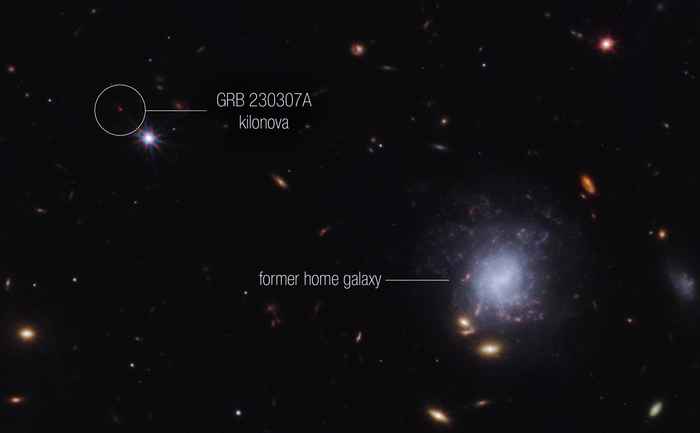Astronomers witness heavy elements emerge after bright gamma-ray burst
25 October 2023

The gamma-ray burst, GRB230307A, is the second brightest burst in the 50 years since the search for gamma-ray bursts began. GRB230307A is a thousand times brighter than the typical gamma-ray burst. The burst lasted a long time, about 200 seconds.
Further investigation with multiple telescopes on Earth and in space revealed that the burst originated from a kilonova. The kilonova probably occurred when two neutron stars merged in a galaxy 1 billion light-years from Earth.
"There are only a mere handful of known kilonovas, and this is the first time we have been able to look at the aftermath of a kilonova with the James Webb Space Telescope," said research leader Andrew Levan (Radboud University, the Netherlands). He was also involved in the first detection of a kilonova back in 2013.
Thanks to the Near-Infrared Spectrograph of the James Webb Space Telescope, developed partly in the Netherlands, the researchers saw peaks in the infrared spectrum of the kilonova that correspond to the typical fingerprint of the element tellurium. The astronomers also observed hints of rare earth elements.
In the future, the researchers hope to do combined observations of kilonovas more often. This will allow them to solidify the theory about the formation of heavy elements in kilonovas.
Scientific paper
JWST detection of heavy neutron capture elements in a compact object merger. By: Andrew Levan et al. In: Nature. [original | preprint (pdf)]
This work has been published in the journal Nature, and made use of many ground and space based telescopes including the facilities of the James Webb Space Telescope, the Chandra X-ray Observatory, the Neil Gehrels Swift Observatory, the Fermi Space Telescope and the facilities of the the European Southern Observatory (ESO), the Gemini Observatory, the Australia Compact Telescope Array, and the MeerKAT telescope.